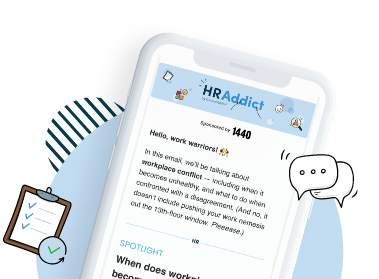Diversity in the workplace is critical for bringing so many organizational benefits, such as fostering collaboration, driving creativity, retaining talent, increasing employee engagement and contributing to business key performance indicators.
Embracing a diverse workforce means that we can tap into the unique talents and perspectives of every employee, which changes where we work for the better. As our working environment becomes richer and more globalized, embracing diversity is not just a measure of success and differentiation — it’s essential.
This article discusses 10 common types of diversity in the workplace, including examples of them, and how they can be promoted and driven in your organization.
1. Cultural diversity
Cultural diversity is one of the richest diversity types out there. It brings together people from various countries and nationalities, recognizing that people from different backgrounds will bring varying approaches to work, such as disparate working styles, ways of communicating, differing viewpoints and unique insights. In these respects, every single national culture is different.
Implement cultural awareness training into your workplace, seeking to demystify cultural differences through education, celebrating national holidays and encouraging employees to share their traditions.
Work to mandate diverse hiring practices and build cross-cultural teams to promote the melding of different perspectives. A good way to add a framework to this is to invest in personality tests to have people from different cultures working in the same team.
2. Linguistic diversity
Linguistic diversity recognizes the varying levels of understanding people have of languages, including those who can only speak one language, and polyglottery — the ability to speak more than one language. Linguistic diversity brings a great deal to the workplace, especially when it comes to dealing with international customers or colleagues from all over the world.
Employers should respect everyone’s level of linguistic diversity by offering support for people coming into an environment that is less familiar with their own native language, using clear and inclusive communication methods.
Ensure that you appreciate and understand those employees who do not wish to learn a different language, or find it hard to do so. Employers should also give employees the opportunity to learn different languages by offering subsidies or free language courses, such as Duolingo or Rosetta Stone programs.
3. Cognitive diversity
Cognitive diversity focuses on the different ways people can think or process information. It can also include neurodiversity, but this can also be grouped into disability, below.
Cognitive diversity includes different attitudes to problem solving, analytical characteristics, and levels or methods of fostering innovation and creativity. It can also cover different levels of cognitive ability.
It’s vital for managers to value and create space for different thinking styles, including recognizing people’s individual contributions, providing flexible and inclusive workspaces that allow people to think in their natural way, and creating teams that meld different ways of thinking.
It’s also important to communicate to everyone the differences in cognitive diversity so that employees can empathize with each other.
4. Socioeconomic diversity
Socioeconomic diversity recognizes employees from upbringings that vary in terms of economic or financial means or levels of education — for example, people raised in affluent areas or those who could not afford to go to university.
People from different socioeconomic backgrounds can have different attitudes to work and typically have been inadvertently shaped into different working environments, which organizations and governments are seeking to correct.
To respect socioeconomic diversity, ensure your compensation levels are consistent and fair, as are training and development interventions. Promote a fair work–life balance and family-friendly work policies to create lasting equality in the workplace. Offering educational programs such as entry-level and experienced hire apprenticeships is another great way to drive socioeconomic diversity.
5. Age diversity
Age diversity focuses on working employees from the different generations represented in the workplace right now, and how their attitude and approach to work differ. These are Traditionalists (born 1925 to 1945), Baby Boomers (born 1946 to 1964), Generation Xers (born 1965 to 1980), Millennials (born 1981 to 2000), and Generation Zers (born 2001 to 2020).
These different generations are best supported through cross-generation mentoring programs and flexible working arrangements. It’s vital also to ensure training and development opportunities are flexible in the way they’re provided, but open to all.
Finally, ensure that your organizational mission and large-scale change management interventions are prepared in such a way to accommodate the varying approaches to work and change that different generations have.
6. Sexual orientation diversity
Sexual orientation diversity is the representation of different sexual orientations in the workplace, including those who are part of the LGBTQIA+ community. Sexual orientation diversity can enrich the workplace through different approaches to work, strong teamwork and collaboration, and an open, trusting and honest environment, full of genuine allyship.
Sexual orientation diversity can be promoted through effective training and communication to all employees on the sexual orientation and LGBTQIA+ landscape, including how it’s evolving. Employers must create safe spaces where employees can feel they can be themselves and promote inclusive celebrations such as Pride Month and similar festivals.
Setting up and driving employee resource groups is another great way to promote sexual orientation diversity, as these create platforms for discussing what’s needed and what’s working well, ensuring the needs of all stakeholders are being met.
7. Racial diversity
Racial diversity focuses on employees from different racial and ethnic backgrounds, going beyond the realms of cultural or linguistic diversity. Having workforces represented by different races and ethnic backgrounds is wonderful for fostering diverse collaboration and approaches to challenges such as problem solving, as well as organizations being able to work with colleagues, clients and stakeholders from all corners of the world.
Racial diversity is best promoted through mandating diverse hiring policies, equal pay programs and equal access to training and development. Promoting a racially diverse leadership team and/or board membership sends a powerful message as well.
Mentorship programs and anti-racism training can give a helping hand to the development of underrepresented groups, and ERGs can bring discussions and education about racial differences to the top of the agenda.
8. Gender diversity
Gender diversity focuses on recognizing the positive impact various genders have on workplaces. Gender diversity brings differing viewpoints and approaches to work, richer teamwork and empathy among employees, and increases camaraderie among employees.
Employers have a legal obligation to focus on gender diversity through promoting equal pay (and, in some jurisdictions, publishing their efforts to do so). They must also implement policies to not only effectively respond to gender discrimination and harassment but also be able to evidence a proactive approach to preventing this occurring in the first place.
Encouraging a balance of genders at all levels of the organization and in different teams, especially in leadership roles, is a powerful and effective way to promote gender diversity.
9. Disability diversity
Disability diversity includes employees with physical, mental, and sensory or neurological disabilities. It covers the need to ensure people of all abilities are given the same opportunities at work to do their job, perform, thrive and be developed. It also seeks to ensure everyone in the workplace is aware of and understands the different forms of disability.
Employers have an obligation to ensure people with disabilities are offered physical, mental and digital accessibility, and reasonable adjustments are made to ensure workplaces are compliant with this. Provide disability awareness training and ensure there are ERGs for people with disabilities.
Finally, foster an open environment where people are comfortable discussing disabilities and interacting with those who might need more support at work. Develop talent acquisition processes that are aimed at attracting and recruiting people with disabilities.
10. Religious diversity
In any workplace, there will be a diverse observance of faiths and religious practices. Employees will live by these religions, and with them comes a rich mix of viewpoints, spiritual perspectives and values. Religious diversity aims to promote these differences and how they can contribute to a richer workforce through understanding and tolerance.
Promote religious diversity through allowing employees of different faiths the space and resources to observe them at work. This could be through recognizing religious holidays and time off or opening a multi-faith space in the workplace.
Celebrate religious celebrations and, above all else, ensure you have a robust policy in place that prohibits religious discrimination. Ensure your grooming policy is developed in a way that is inclusive of people of all religions, as well as no religion.
Final thoughts
Driving diversity in the workplace is often legally mandated, but we don’t just do it because we have to. Recognizing all types of diversity means that the modern workplace can leverage the potential of their workforce, no matter how it's made up, immeasurably adding to a positive working culture.
Managing diversity comes in many different ways as we have discovered, but it must be embedded deep within the organization, driven by leaders, incorporated into policies and values, and followed through by employees at all levels. Only then will diversity have the incredible positive effects that it can foster in organizations.
How do you promote diversity in the workplace? Let us know in the comments section below!

